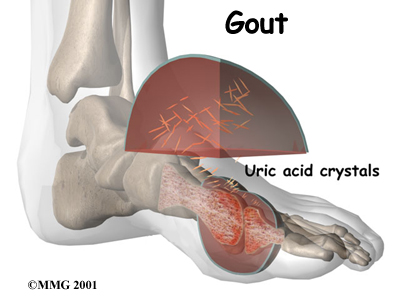Gout Video
Definition of Gout:
Gout is a form of arthritis that causes the inflammation, joint pain and swelling especially in the toe, knee and ankle, also reducing their mobility. Gout usually appears in midlife and primarily in males. It can be hereditary or the secondary to some other disease process.
What are the causes of Gout?
Gout is mainly caused by the clustering of uric acid crystals in the arteries, obstructing normal blood flow and causing inflammation. Uric acid is a residual product that is excreted from the body through urine during synthesis of purine – a substance that presents in fat meats, fish, some dairy products and vegetables. The level of uric acid can be found and measured in the blood.
What are the first signs of gout attacks?
In most cases, the first gout signs appear at the level of the big toe. The skin around the affected regions turns yellow, appears to be stretched and bruised. The regions affected by gout become very sensitive. It even causes the sufferers can’t tolerate clothing or shoes. Gout attacks in the region of the big toe are referred to as podagra and they involve inflammation, swelling, pain and a sensation of burning. Podagra can also occur due to acquired injuries or intense physical effort that involves the lower limbs.
Apart from the region of the toes, recurrent attacks also involve pain and inflammation of the knees, elbows, shoulders, wrists and fingers. Most types of gout attacks can generate low to moderate fever and sweating.
And when gout becomes chronic, the damage to the joint is deforming and crippling. Chronic gout attacks are usually long-lasting and they occur in multiple regions of the body.
What are the main symptoms of Gout?
The main symptoms of gout are severe pain and swelling in joints. It’s the crystallized and lodged of uric acid in the joints that cause joint pain. The joint gets hot, swollen and tender. In most cases, the pain attacks seem to amplify at night causing sleeping difficulty to many patients. How long can gout pain remain? The pain may remain anywhere from a few minutes to a few hours and in some cases, even days. As the disease progresses, the duration of gout attacks can exceed 7-10 days.
Other common gout symptoms include fever, discomfort, sourness, malaise, tachycardia, elevations in skin temperature, itching sensations, body aches, water retention, inflammation and intense pain of the affected area – gout in the knee cause joint pain in the knee whereas gout in the finger or toe cause pain in finger or toe. The skin in the affected regions often looks stretched. Gouty arthritis may also cause back pain since it affects the joints.
What are the treatments for Gout?
There are few treatments available for treating gout.
- Medicines – Non-steroidal anti-inflammatory drugs (NSAIDs) to relief the pain and inflammation in your joint.
- Steroid Injection – Injection is a targeted approach directed into your joint
Gout Specialist
Dr Kevin Yip, Orthopaedic Specialist
Or you can make an appointment here with us now!

